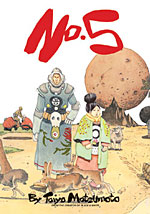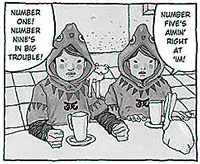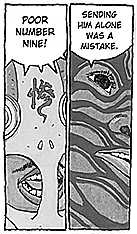
 Writer/Artist: Taiyo Matsumoto
Writer/Artist: Taiyo Matsumoto
Price: $15.95
Publisher: Viz Communications
ISBN: 1-56931-738-0
No. 5 is the fifth member of the Rainbow Council, an elite team of International Peacekeeping superhumans. No. 5 is the Council's greatest warrior, an expert sharpshooter with a really big sniper rifle. No. 5 has allegedly gotten a girl pregnant. No. 5 has disappeared with said girl.
The eight remaining members of the Rainbow Council are after him. And as the story opens, No. 5 kills No. 9 with a remorseless shot through the back from miles away. And No. 5 liked No. 9.
And this, as simple as it sounds, is the plot for Taiyo Matsumoto's beautifully bizarre NO. 5. A love and chase story, with political and conspiratorial overtones. But delving into it, you'll find that plot takes a backseat to the images and concepts that are littered in every panel, on every page.
But you probably won't realise this if you only give it a quick once over. At first glance, with the opening scene of sudden, needed violence and the wasteland setting, you might be forgiven for thinking you've stumbled upon an issue of HEAVY METAL. You might be forgiven - after all, it is in some ways a homage to the classic 70s French sci-fi of Bilal. NO. 5 does have the odd bit of ultraviolence, but it has less tits and more class than HEAVY METAL. And more brains.
 NO. 5 is the first volume in series, so apart from the chase to catch No. 5, Matsumoto introduces the other numbered members of the Council. Each member is in charge of a part of the strange earth they inhabit, and each has a specific strength. So we see a long flashback on the life of No. 9; The afro'd No. 7, keeping the children of his island smiling and happy so they won't become soldiers; Disgruntled No. 6, who used to be No. 1; The twin psychic children, both occupying the position and title of No. 4; The speed-loving, rev-head No. 2; the newly appointed No. 1, a conspirator in a conspiracy; and Papa, the brains behind the council. Papa is a genius. We know this because he wears glasses... and has the word GENIUS spelt down the front of his bunny suit.
NO. 5 is the first volume in series, so apart from the chase to catch No. 5, Matsumoto introduces the other numbered members of the Council. Each member is in charge of a part of the strange earth they inhabit, and each has a specific strength. So we see a long flashback on the life of No. 9; The afro'd No. 7, keeping the children of his island smiling and happy so they won't become soldiers; Disgruntled No. 6, who used to be No. 1; The twin psychic children, both occupying the position and title of No. 4; The speed-loving, rev-head No. 2; the newly appointed No. 1, a conspirator in a conspiracy; and Papa, the brains behind the council. Papa is a genius. We know this because he wears glasses... and has the word GENIUS spelt down the front of his bunny suit.
Of course, people who are familiar white Matsumoto's three volume series Black and White, will be aware of the artist's love of thrusting the reader into a world that is at first glance alien and surreal, but utterly familiar.
It's the bizarre entities with which Matsumoto has populated his world that really amazes you. It's the details that count. He's done it in such a way that it at first glance it looks surreal. But why? Characters in the book wears animal masks, or talk to disembodied heads. 20th Century pop culture references are splattered throughout, from Matroshka, the near-silent woman No. 5 took from No. 1's stronghold, eating M&Ms, to a Michael Jackson coffee mug, all in between sudden bursts of the old ultraviolence. The world is, on the outside, an environmental utopia, everything fitting into the surroundings - even the Council's planes being shaped like wasps, right down the stripes on the thorax. The bizarre is the everyday in the world of No. 5.
 Matsumoto's art is reminiscent of Hugo Pratt, with a touch of Frank Miller circa RONIN. It's been noted that his art, like that of Paul Pope, crosses cultural lines, merging European comic and manga sensibilities, with a confidence not often seen in comics. His ideas and visuals convey this. Matsumoto himself has said, "American comics are powerful and cool. European comics seem very intellectual. And Japanese comics are very light-hearted. If you could combine the best of all three, you could create some really tremendous work. That's my goal."
Matsumoto's art is reminiscent of Hugo Pratt, with a touch of Frank Miller circa RONIN. It's been noted that his art, like that of Paul Pope, crosses cultural lines, merging European comic and manga sensibilities, with a confidence not often seen in comics. His ideas and visuals convey this. Matsumoto himself has said, "American comics are powerful and cool. European comics seem very intellectual. And Japanese comics are very light-hearted. If you could combine the best of all three, you could create some really tremendous work. That's my goal."
And he succeeds. The panels move easily from squares and rectangles to lopsided Pythagorean spaces and thin angry triangles. The layouts project calm one minute - wide-angle shots of the voracious Matroshka eating in a valley while No. 5 tries to show her flowers, and all the animals falling in love with her - before breaking out into kinetic and brutal action as No. 5 takes down another attempt on his life in a gun-versus-rocket-launcher confrontation straight out of a HK action film.
His recounting of the story at the beginning of each chapter (as NO. 5 was originally serialised) is in simple, child-like drawings, or twisting maps of structure. He uses words to label pictures, the same way Anglo artists like Ashley Wood do; a tiny foetus, labelled 'This small'. There's even a map of No. 5's escape route, depicting the rare lifeforms of the world of NO. 5 and the cities where each council member lives.
The presentation of the book is one of the first things that caught my attention. The soft cover has an embossed dust-jacket, and like the recent Dark Horse AKIRA trades, the first few pages are in colour, full of watercolour earth tones, greens and browns and reds, setting the scene for the desert to which No. 5 and Matroshka flee.
SF writer Brian Aldiss recently stated that science fiction should be classified as 'surrealism'. No. 5 certainly fits into this mould: it's got surrealism to burn.

This article is Ideological Freeware. The author grants permission for its reproduction and redistribution by private individuals on condition that the author and source of the article are clearly shown, no charge is made, and the whole article is reproduced intact, including this notice.


